LONDON: Hollywood star Johnny Depp wrapped up five days of gruelling testimony Monday in a libel trial that has exposed the dark underbelly of the lifestyles of the rich and famous.
The “Pirates of the Caribbean” franchise hero is suing the publisher and executive editor of Britain’s The Sun tabloid newspaper over a 2018 story branding him a “wife beater.”
The 57-year-old denies abusing actress Amber Heard — now 34 and the global face of French cosmetics firm L’Oreal — during a rocky two-year marriage that ended in a messy 2017 divorce and several lawsuits.
But he has admitted a debilitating drug habit and allowed the defense to air graphic details of 14 assault allegations that made headlines around the world.
Some legal experts following the High Court hearing in London question why Depp decided to put himself through the three-week ordeal given the subject matter being aired.
“He’s been extremely ill-advised to pursue this,” Mark Stephens, a leading media specialist at London law firm Howard Kennedy, told AFP.
“To expose (difficult divorces) to forensic examination is the height of stupidity or hubris.”
Here are the main points that have emerged from the trial so far.
Hollywood’s drug culture has provided the backdrop for the entire hearing.
Depp told the court on Friday that he snorted cocaine to help break his addiction to painkillers.
He argued Thursday that he was suffering from withdrawal while coming off of drugs and was in “no physical condition” to hurt Heard during one alleged incident on his private Bahamas island.
Depp further explained the party drug ecstasy had little effect on him and that he preferred to leave it to Heard and their celebrity friends.
The actress herself was alleged to have sent a party invitation with instructions: “Bring some food, booze and drug of choice, yey!“
Another text Heard allegedly sent from Depp’s phone asked a friend to “procure more mushrooms.”
“Amber Turd” began trending on Twitter after Depp spent a part of Friday trying to explain how a large stool ended up in the couple’s bed in 2016.
Both of them were alleged to have been involved in extramarital affairs at the time and Depp claimed it was left there as revenge by either Heard or one of her friends on her 30th birthday.
Depp called the defense’s claim that it was from one of their dogs “physically impossible” because it was simply too big.
“There were jokes like ‘Amber Turd’, ‘Amber in the dumps’ going on,” defense attorney Sasha Wass told Depp sternly.
Depp professed his innocence and called the incident a “mystery.”
One of the darkest episodes involves an allegedly high and drunk Depp scrawling messages to Heard on a mirror and wall with the blood of his severed finger.
Depp acknowledges dipping the finger in a can of paint to continue writing once the bleeding stopped.
But he denies tripping on ecstasy at the time and claims Heard slashed off the tip of his finger with a bottle during a particularly bad fight.
The defense says he hurt it while “completely destroying” the couple’s vacation home in Australia.
Depp said Thursday that he was experiencing “some kind of breakdown” and was feeling suicidal at the time.
Mark Stephens said both Depp and Heard had plenty to lose and little to gain from the proceedings.
“His reputation will be permanently stained if he is found to be abusive.”
And “if Heard is not to be believed, she will find it very hard to find work in Hollywood.”
British libel law puts the burden of proof on the defense and gives Depp the initial advantage.
But the judge told Heard her upcoming testimony would not be bound by “confidentiality restrictions” agreed in the divorce.
Depp may find it even harder to clear his name in a separate defamation lawsuit he filed over an op-ed about the alleged abuse that Heard wrote in The Washington Post.
That hearing is expected to begin in August in Virginia under US laws putting the burden of proof on Depp.
High stakes in Johnny Depp libel hearing
https://arab.news/vcnke
High stakes in Johnny Depp libel hearing

- The 57-year-old denies abusing actress Amber Heard — now 34 and the global face of French cosmetics firm L’Oreal
- Some legal experts following the High Court hearing in London question why Depp decided to put himself through the three-week ordeal
Dave Chappelle to perform at Abu Dhabi Comedy Week

DUBAI: US award-winning comedian Dave Chappelle is set to perform in the UAE at the Abu Dhabi Comedy Week on May 23, organizers announced on Friday.
The capital city’s first-ever comedy festival will run from May 18-26 at Yas Island’s Etihad Arena.
Chappelle will join a long list of comedians performing at the event, including Chris Tucker, Aziz Ansari, Tom Segura, Jo Koy, Tommy Tiernan, Kevin Bridges, Andrew Santino, Bobby Lee, Andrew Schulz, Bassem Youssef and Maz Jobrani.
With numerous accolades and awards to his name, including multiple Grammy Awards and Emmy Awards, Chappelle is renowned for his wit and fearless commentary on contemporary issues.
While May 23 will mark Chappelle’s inaugural performance in Abu Dhabi, he has previously captivated audiences with two sold-out shows in Dubai.
Manal AlDowayan on her work for the Venice Biennale
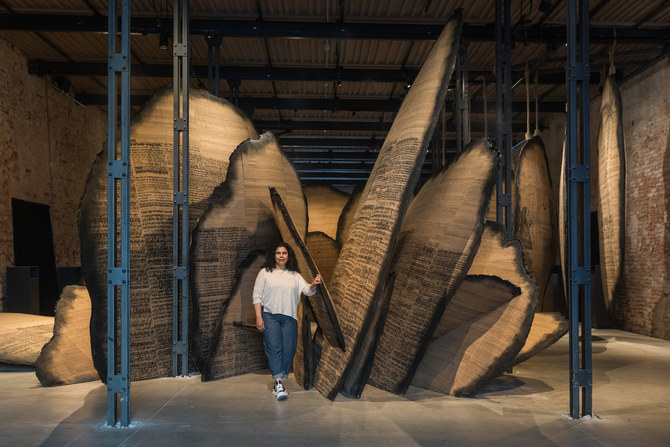
- The acclaimed artist is representing Saudi Arabia at this year’s ‘Olympics of the art world’
DUBAI: The acclaimed Saudi artist Manal AlDowayan is on a roll. Earlier this year, she opened two well-received exhibitions in AlUla, where she is also working on an ambitious land art commission for the upcoming Wadi AlFann cultural destination. And this week, AlDowayan will represent her country at the 60th iteration of the Venice Biennale — dubbed “the Olympics of the art world,” consisting as it does of multiple national pavilions — which runs until Nov. 24. She will be presenting what she describes as “two of my most major works in my career at this point.”
AlDowayan has participated at Venice before. In 2009, she showed her work in an onsite exhibition organized by the Saudi art-focused initiative Edge of Arabia, alongside fellow Saudi artists including Maha Malluh and Ahmed Mater.
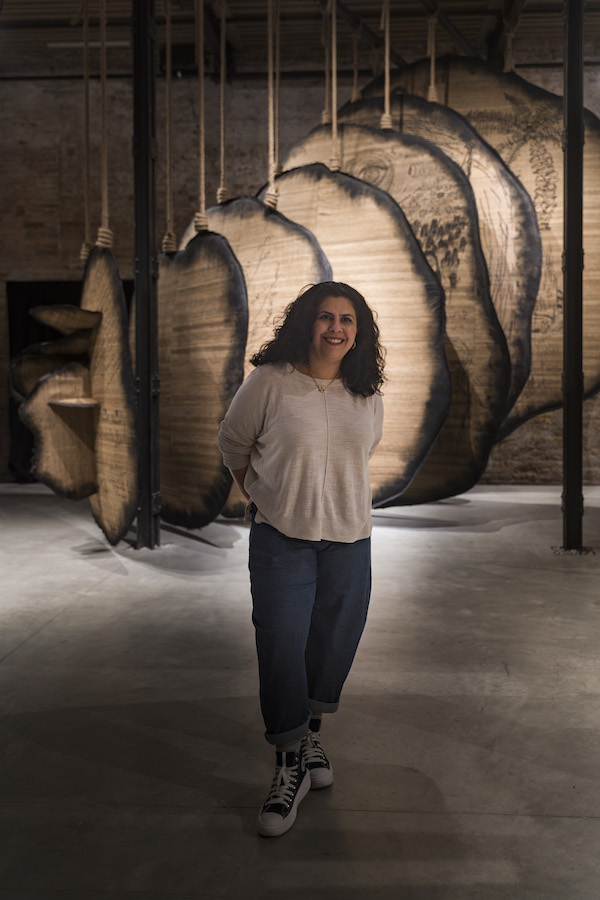
“I’ve been going to Venice for about 12 years,” AlDowayan tells Arab News. “The first time I showed there, I knew in my heart that I would be coming back to represent Saudi Arabia; I would do everything in my power to come to this moment and prepare myself. It’s something very important for an artist: to participate in the Venice Biennale.”
It was only last August that she was visited in her UK studio by Dina Amin, the CEO of the Visual Arts Commission, and cultural advisor Abdullah Al-Turki, and told she had been selected to represent the Kingdom in 2024.
“My first thoughts were: ‘There’s no time,’” she says with a laugh. “To come up with a concept, complete the research, execute the concept, build it, and install it, is really complex. But my team, my studios, and I were ready. I already knew what I wanted to present, and within one week I had put together my proposal and it was approved. The artwork is a continuation of my language, my research and my forms that I work with.”
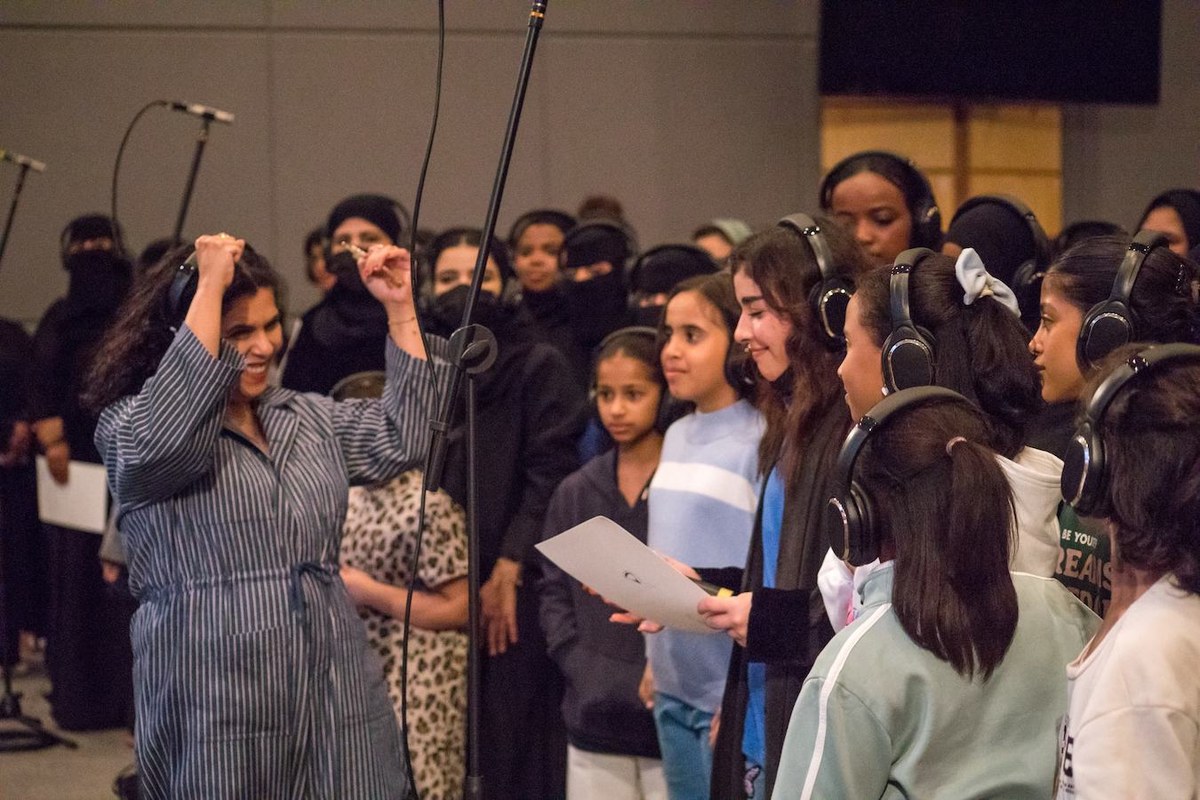
The Saudi pavilion’s theme at Venice this year is “Shifting Sands—A Battle Song.” It is curated by a trio of female art experts, Jessica Cerasi, Maya El-Khalil, and Shadin AlBulaihed. In AlDowayan’s sound-meets-sculpture installation, she brings together much of what she has explored in her practice over the past two decades — community engagement, participatory art, media (mis)representation, and the visibility, or lack of it, of women in Saudi culture. The work is also about the momentous changes taking place in the Kingdom today, and her response to them.
The work comprises two key parts: sound and soft sculptures. Saudi and Arab women’s voices are front and center; AlDowayan allowing them to reclaim their narrative, which she believes has consistently been misrepresented.
“If you’re always told that you’re oppressed, repressed, depressed… you sort of lose the sense of yourself,” she adds. “And this artwork talks about this sort of constant hounding by Western media — and local media — speaking about the Arab woman; her body, her space, the rules of her behavior, and how she should exist in the public space.”
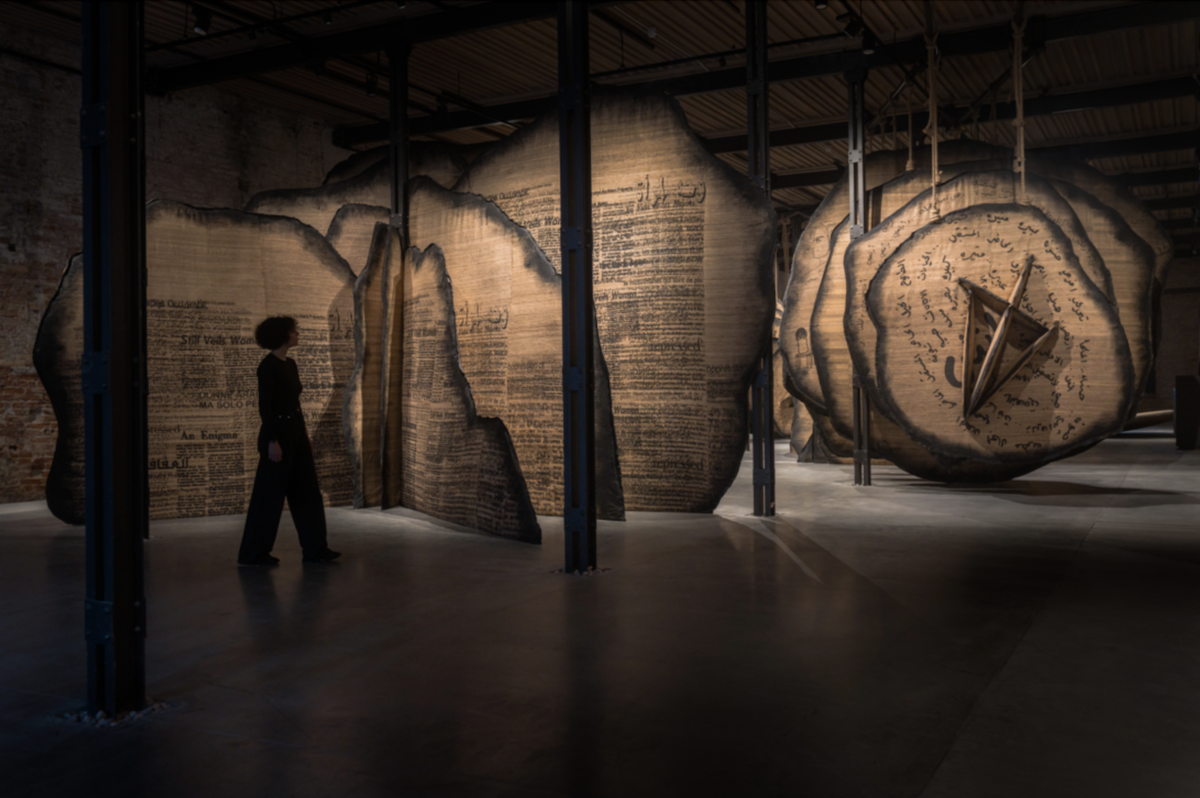
For this section, AlDowayan put out an open call inviting women to take part in workshops. They proved very popular, attended by all ages, professions and backgrounds.
“In Riyadh, within three hours, 350 women registered,” she says. “We had to block the registration link because I don’t know how to control 350 women. I’m just one.” In the sessions, participants reacted to negative press headlines and media clippings, and AlDowayan recorded those reactions.
“I always say that people are trying to define what a Saudi woman is,” explains AlDowayan. “We researched thousands and thousands of articles in my studios, in seven languages, and there were some very dark things written. I showed the women these articles and said, ‘Do you really feel these articles are really speaking your truth?’”
She also asked them to write and/or draw their own stories. Examples included: “Two women equal one man.” “Thanks love, we don’t want to be saved.” And “Surrendering doesn’t look good on us, for we are wars.”
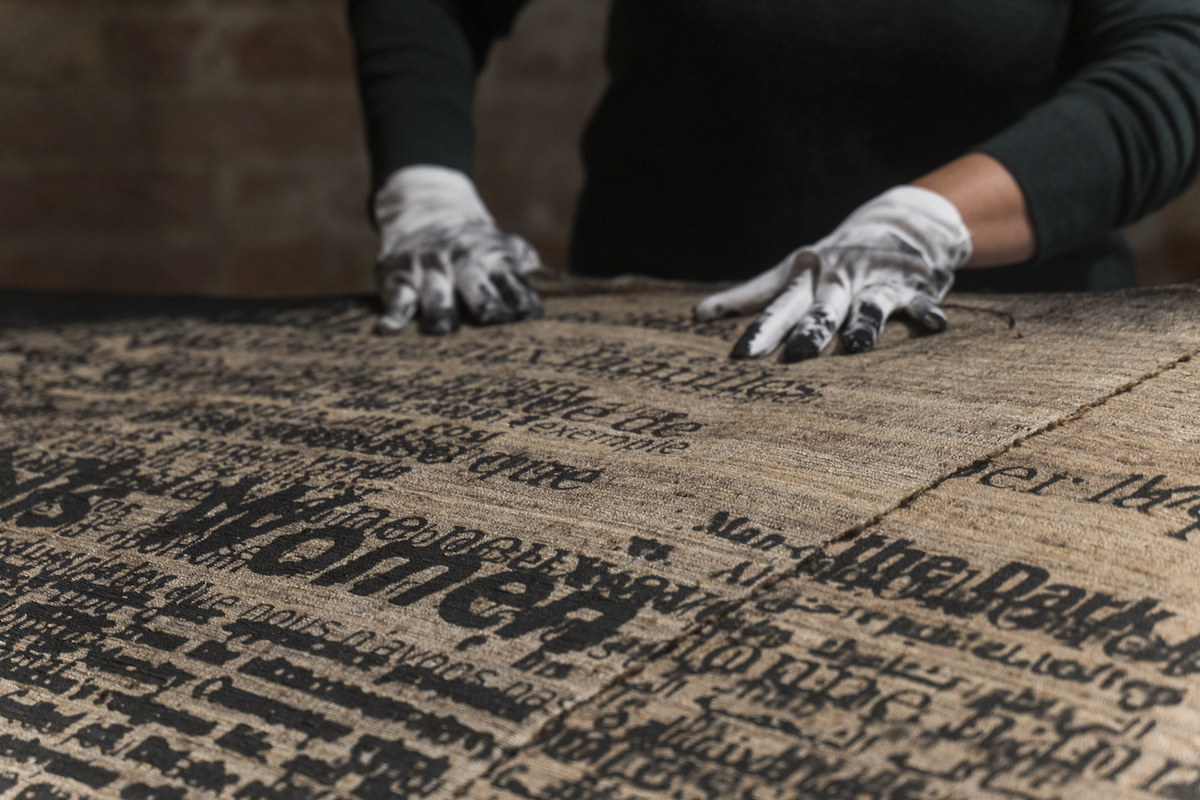
A selection of the written quotes were then read out loud by participants. While reading, they had headphones on, listening to, and harmonizing with, the eerie humming sounds made by sand dunes, which AlDowayan had previously recorded.
“It was beautiful and meditative. You will see women with their eyes closed, their arms stretched out. It was a very spiritual moment,” AlDowayan recalls. The whole ‘performance’ was inspired by ‘Dahha,’ a ritual in which warriors celebrated victory with music and dance.
Inside the pavilion, where the women’s recordings play, stand three soft black-and-brown sculptures, full of folds, shaped like the sand crystals known as desert roses — a recurring motif in AlDowayan’s work.
“The rose is a very weak and delicate (thing),” she says. “But this crystal is born in extreme circumstances. First, it needs to be pouring rain, then there needs to be high temperatures and that’s how it crystalizes. I feel like I’ve adopted this form as a body and I deal with it like skin.”
The folds of the enlarged sculptures are imprinted with “a cacophony of what Western media has written: the veil, repressed, oppressed, women, sexuality… All the words that always float over our heads,” says AlDowayan. They also include some of the women’s positive messages, as well as their drawings.
“While you’re taking this journey you will hear the sound, and sound is sculptural in my opinion: It occupies but you can’t see it,” she says. “I feel the invisibility of sound, and its ‘presence’ is like the Arab woman. She’s strong, she’s there; it’s undeniable. Just because you don’t see her, it doesn’t mean she doesn’t exist.”
As for how visitors will react to her work, AlDowayan hopes to provoke conversations.
“I want questions. I want extreme emotions. They can hate it, they can love it, they can cry. But, I can’t do neutral,” she says. “Neutral means I did not succeed. If they have questions, then I’ve succeeded. If they talk about it after one day, I’ve succeeded.”
US Kuwaiti artist Latifa Alajlan — ‘I used to compare myself to other artists’
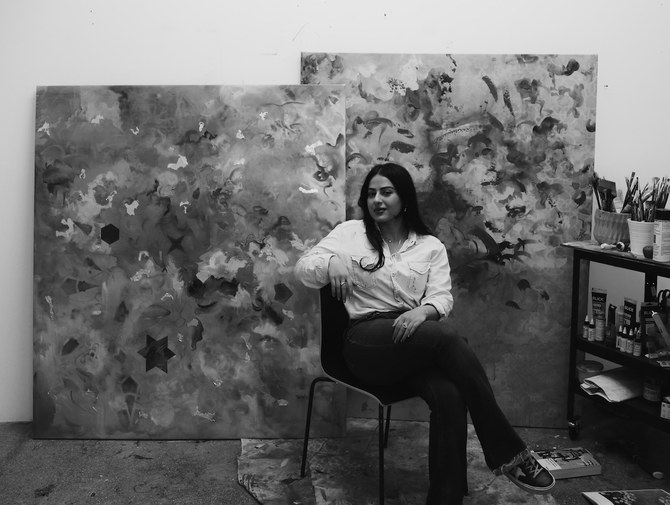
- The third in this year’s series focusing on contemporary Arab-American artists in honor of Arab-American Heritage Month
DUBAI: Kuwaiti artist Latifa Alajlan moved to America in 2016 to study art at Grossmont College in San Diego, followed by a Master of Fine Arts program at the School of the Art Institute of Chicago, where alumni include major American artists Georgia O’Keeffe, Joan Mitchell and Grant Wood.
Now, Alajlan is based in New York, where she is represented by Franklin Parrasch Gallery. “New York is the Makkah of the art world,” she tells Arab News. “You have so many galleries and institutions — that’s what I do every Friday. It’s very meditative for me and I enjoy walking around the city.”
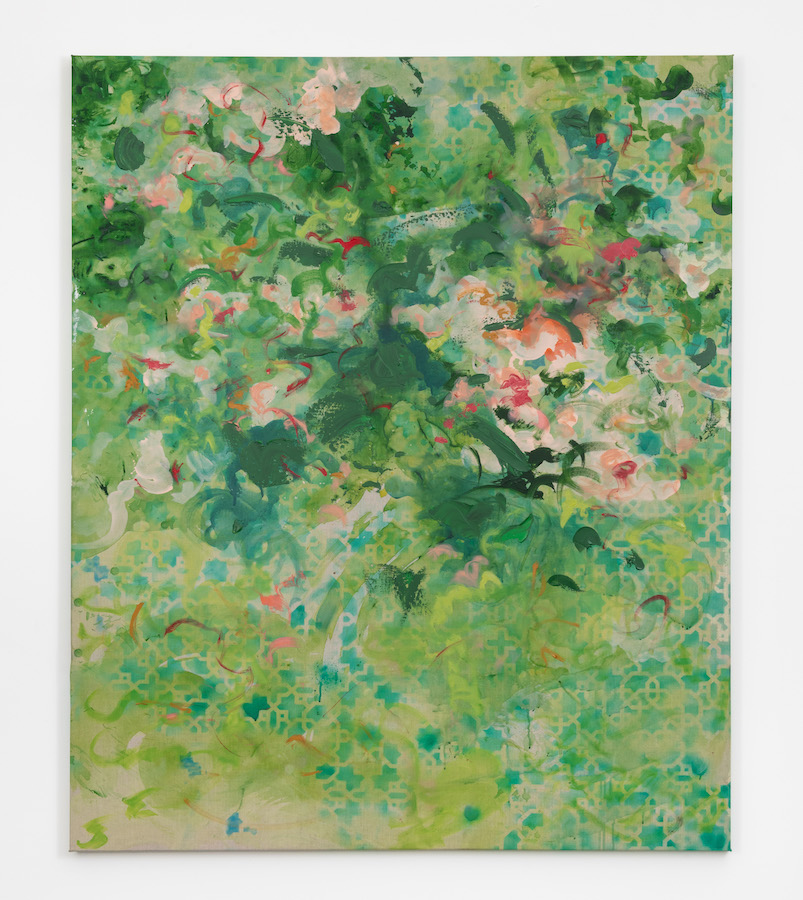
But she is also aware of the competition in such an established artistic environment. “In New York, when you’re a young artist what’s dangerous about it is that you compare yourself to other artists,” she says. “I used to do that a lot and I had to take a step back and realize it was unhealthy. Everyone has their own journey.”
Hers began in Kuwait, where her parents, especially her strict father, would “force” Alajlan and her siblings to visit museums and write essays on artworks. “I just didn’t understand. People were enjoying their summer, and we were going to museums,” she says. “That was boring.”
Now, however, Alajlan can look back on her childhood and understand her parents’ intentions. “That’s what I appreciate: the fact that they kept pushing me,” she says.
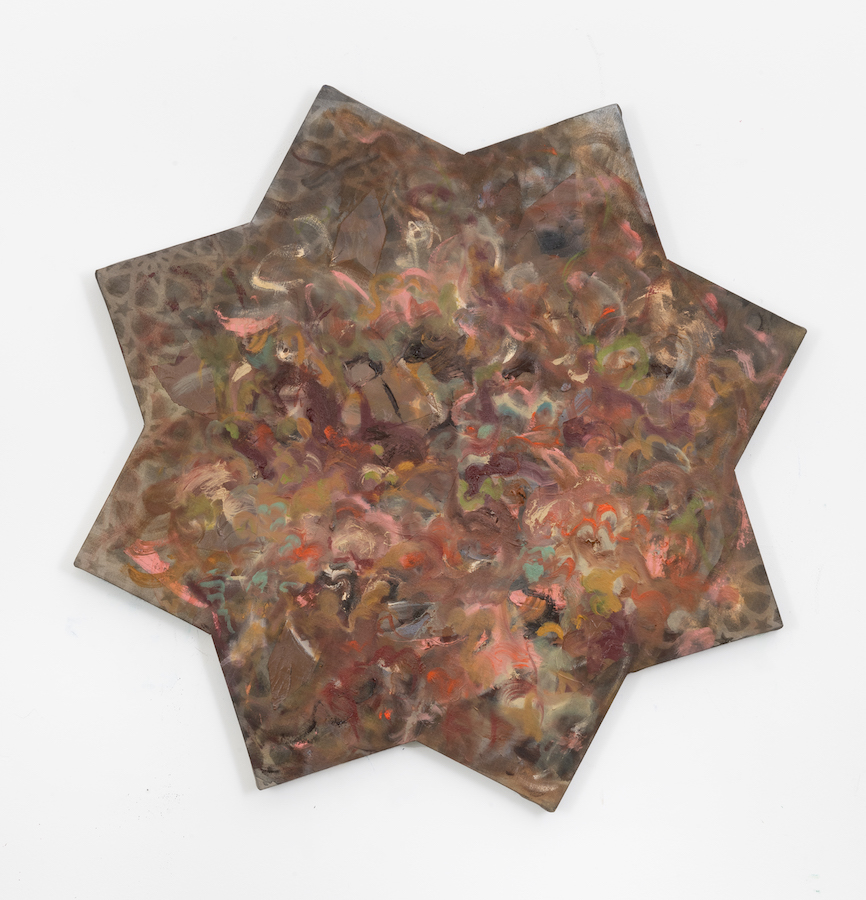
As for her creative practice, Alajlan has experimented with ceramics, glass-blowing, blacksmithing and sculpting. But such labor-intensive mediums weren’t for her. “I almost lost my fingers,” she says. “It’s intense. . . I’ve realized painting is my thing.”
Through her abstract work, Alajlan addresses political, cultural and architectural attributes of her homeland. But she finds inspiration everywhere, she says — from her friends to conversations with strangers. There is an element of mystery to her canvases; she might hide certain parts of her composition with splodges of paint, filling them with gentle gestural strokes and motifs from mosques.
“To me, painting is very therapeutic,” she says. “It’s my way of praying.”
Recipes for success: Chef Lorenzo Buccarini offers advice and a pasta and caviar recipe

DUBAI: “I discovered my passion for cooking at a young age, being drawn to the sights and smells from my family’s kitchen,” Zenon Dubai’s executive chef Lorenzo Buccarini tells Arab News. “My earliest memory of cooking is helping my grandmother prepare lasagna. Those moments ignited a lifelong love affair with the culinary arts.”.
Zenon, located at Kempinski Central Avenue in the heart of Downtown Dubai, offers Mediterranean and Asian cuisine.
“Working with Zenon Dubai has been an enriching experience filled with creativity and collaboration, allowing me to push boundaries,” said Buccarini.

From the vibrant culinary scene of London in 2012 to Istanbul in 2014, Bali in 2016, and Morocco in 2018, Buccarini has dabbled in an array of cuisines over the years. Here, he discusses his go-to dish, favorite cuisine and most challenging dish to prepare.
Q: When you started out, what was the most common mistake you made?
A: Underestimating the importance of proper seasoning. Achieving the perfect balance of flavors is essential in every dish, and mastering seasoning techniques was a valuable lesson early in my career.
What’s your top tip for amateur chefs?
Invest in quality ingredients and don’t be afraid to experiment. Additionally, learn fundamental cooking techniques such as knife skills and proper seasoning, as they form the foundation of any great dish.
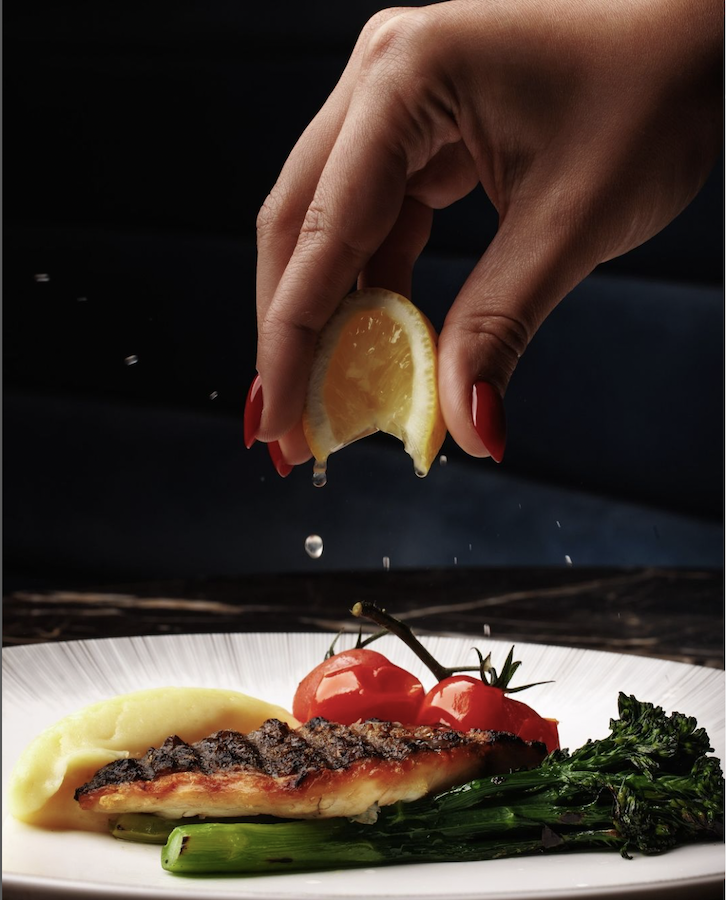
What one ingredient can instantly improve any dish?
Fresh herbs — whether it’s parsley, basil, cilantro, or thyme, incorporating fresh herbs adds depth and complexity to your cooking. They elevate the flavor of any dish.
When you go out to eat, do you find yourself critiquing the food?
Naturally, as a chef, I pay attention to the details if I’m dining out.
What’s the most common issue that you find in other restaurants?
Something I often notice is inconsistency in execution — whether it’s undercooked proteins, over-seasoned dishes, or lackluster presentation. Consistency is key to delivering memorable dining experiences.
And what’s your favorite cuisine when you go out?
I do enjoy exploring different cuisines, but if I had to choose a favorite, it would have to be classic Italian cuisine. There’s something inherently comforting and soul-satisfying about dishes like homemade pasta or a perfectly cooked risotto that never fails to delight the palate.
What’s your go-to dish if you have to cook something quickly at home?
Spaghetti aglio e olio. It’s a simple yet flavorful pasta dish made with garlic, olive oil, chili flakes, and parsley. It’s quick to prepare and showcases the beauty of minimalistic Italian cooking.
What customer behavior most annoys you?
It can be frustrating when customers request significant modifications to a dish without considering the integrity of the recipe. While accommodating dietary restrictions is important, excessive alterations can compromise the intended flavors and balance of the dish.
What’s your favorite dish to cook?
One of them is osso buco. It’s a classic Italian dish made with braised veal shanks, aromatic vegetables, and a rich tomato-based sauce. The slow cooking process allows the flavors to meld together beautifully, resulting in a dish that’s hearty, flavorful, and deeply satisfying.
What’s the most difficult dish for you to get right?
For me, mastering the perfect risotto has always been a challenge. Achieving the ideal balance of creaminess and texture while ensuring the rice is cooked to perfection requires precision and attention to detail. It’s a dish that demands patience and practice to get just right.
As a head chef, what are you like? Are you a disciplinarian? Or are you more laidback?
I try to maintain a balance between discipline and approachability. I do set high standards for my team, and I expect professionalism in the kitchen, but I believe in fostering a supportive and collaborative environment. Effective communication and mutual respect are essential for success in any kitchen.
Chef Lorenzo’s pasta, cream reduction and caviar
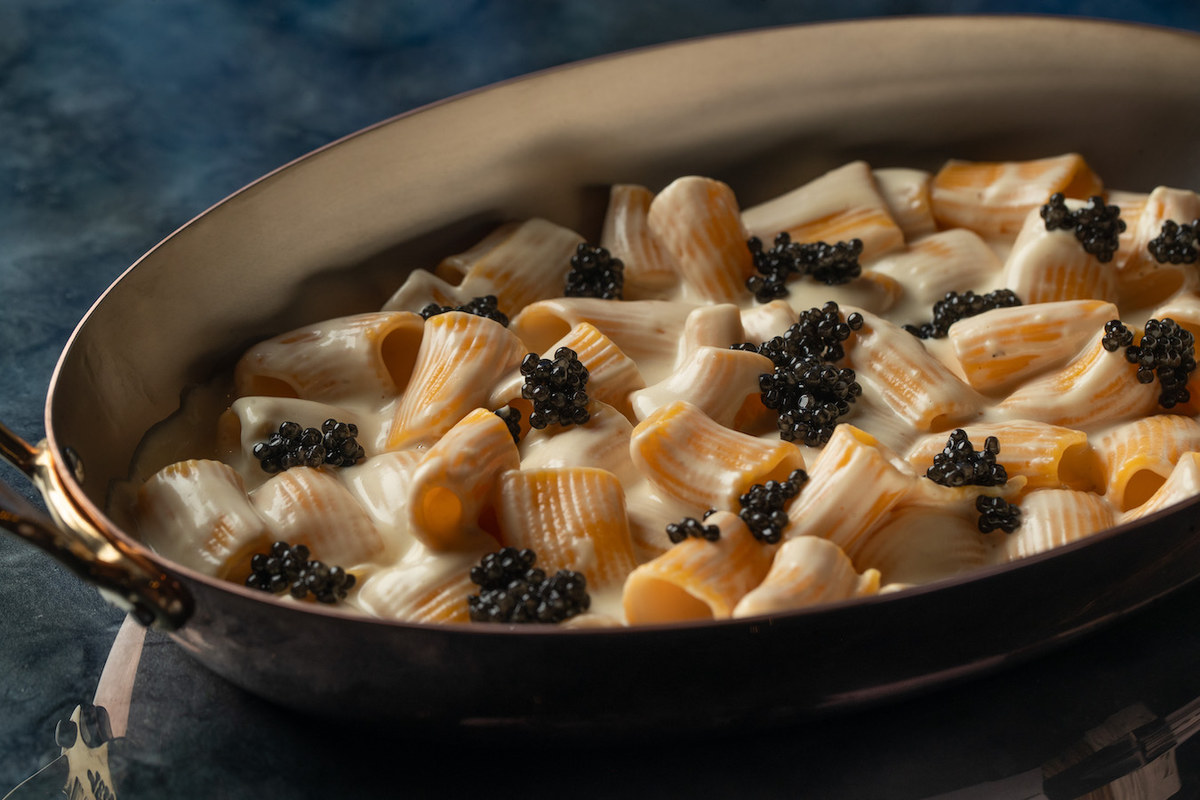
INGREDIENTS
For the cream reduction: 1L double cream; 500g dried porcini; 1L water
For the fresh pasta (can be substituted for store-bought pasta): 600g semolina flour; 1400g 00 flour; 8 fresh eggs; 300g water
INSTRUCTIONS
1. To reduce the cream, add it to a pan and gradually reduce the heat to a slow boil, stirring frequently. As the water boils off, the cream will be reduced. You want to reduce it by half. Then place the pan to one side.
2. For mushroom stock, add the dried porcini to a pan with the water and simmer for one hour. Strain immediately. Reduce the stock by ¾.
3. For the pasta, mix all ingredients together to make a dough. Put in the fridge for one hour. Remove from the fridge and shape it as you like (here at the restaurant we do rigatoni). You can just use standard, store-bought pasta too.
4. Cook the pasta in boiling water for five or six minutes (or as instructed for store-bought pasta), then drain.
5. Put 250g of the cream reduction and 20g of reduced mushrooms into a hot shallow pan. Add a pinch of salt. Add the pasta to the sauce. Stir. Add a little parmesan and top with caviar.
REVIEW: Netflix’s ‘Crashing Eid’

Shying away from the traditional, comedy television show “Crashing Eid” presents quite a progressive viewpoint — but certainly not an uncommon one.
The four-episode series follows the story of Razan, an independent young Saudi woman who fled her old life and built a new one in London along with her teenage daughter Lamar — only to find herself in love with a Pakistani Brit, Sameer.
The show opens with a surprise spin as Razan takes it upon herself to initiate a proposal to Sameer, who she has known for two years. She and her daughter then plan to take a short trip back to hometown Jeddah during Ramadan, without her family knowing that she has no plans to move back home — or that she is engaged.
Sameer decides to return the surprise by showing up to her family’s home, only to be met by Razan’s father, who mistakes him for a maintenance worker. This spurs the show into a flurry of misunderstandings and awkward interactions that surface some rather crucial unresolved family issues and traumas.
As Saudi has become more global in its population, in many ways including international marriages, the issues in “Crashing Eid” have become more vital to discuss than ever.
Rather than focusing on the difficulties that come with marrying a foreigner, such as lengthy legal procedures and official marriage approvals, the show hones in on societal acceptance. The aspects of honor and locality of marriage are brought to the surface.
The show also uses the main plot to dig up some underlying issues prevalent in any society, not just in Saudi Arabia. Through Razan’s homecoming, she is forced to revisit the reality of her previous marriage to Lamar’s father, who had been physically abusive. Choosing to leave him and start a new life abroad, she is met with societal condemnation and victim blaming.
While Razan’s brother Sofyan battles divorce and child custody issues, the family reveals the challenges of generational gaps. It also demonstrates the common shift to the globalization of younger generations and the tight hold on traditions within older ones.
The show has a unique way of making difficult or rather taboo topics palatable for a general Saudi audience. It sets the table for conversation, at the very least.
Sure, some of the acting seemed fairly novel, reminiscent of early 2000s sitcoms sans the laugh track, and the show also had a peculiar style of direction and editing.
But certainly, “Crashing Eid” must be applauded for its bold statements, proving that it is not afraid to rock the boat for the chance to tell authentic Saudi stories. For anyone looking to get a deeper sense into the modern-day Saudi household, the show is a must-watch.















